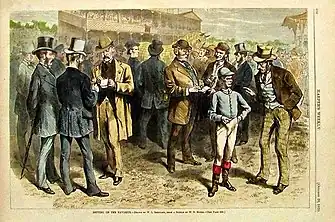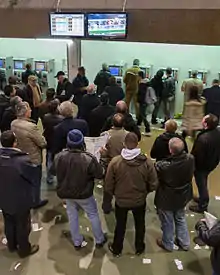Betting on horse racing
Betting on horse racing or horse betting[1] commonly occurs at many horse races. Modern horse betting started in Great Britain in the early 1600s during the reign of King James I.[2][3] Gamblers can stake money on the final placement of the horses taking part in a race. Gambling on horses is, however, prohibited at some racetracks. For example, because of a law passed in 1951, betting is illegal in Springdale Race Course, home of the nationally renowned Toronto-Dominion Bank (TD Bank) Carolina Cup and Colonial Cup Steeplechase in Camden, South Carolina.

Where gambling is allowed, most tracks offer parimutuel betting where gamblers' money is pooled and shared proportionally among the winners once a deduction has been made from the pool. Parimutuel betting also provides purse money to participants and a considerable amount of tax revenue, with over $100 billion being wagered annually in 53 countries.[4][5][6]
In some countries – notably the UK, Ireland, and Australia – an alternative and more popular facility is provided by bookmakers who effectively make a market in odds. This allows the gambler to 'lock in' odds on a horse at a particular time (known as 'taking the price' in the UK).
Types of bets

In North American racing, the three most common ways to bet money are to win, to place, and to show. A bet to win, sometimes called a "straight" bet, means staking money on the horse, and if it comes in first place, the bet is a winner. In a bet to place, you are betting on your horse to finish either first or second. A bet to show wins if the horse finishes first, second or third. Since it is much easier to select a horse to finish first, second, or third than it is to select a horse just for first, the show payoffs will be much lower on average than win payoffs. If there are a small number of horses in the race, show or place bets may not be offered (or if bets have already been made, they are cancelled and the wagered amounts refunded).

In Europe, Australia, and Asia, betting to place is different since the number of "payout places" varies depending on the size of the field that takes part in the race. For example, in a race with seven or less runners in the UK, only the first two finishers would be considered winning bets with most bookmakers. Three places are paid for eight or more runners, whilst a handicap race with 16 runners or more will see the first four places being classed as "placed". (A show bet in the North American sense does not exist in these locations.)
The term each-way (E/W) bet is used everywhere but North America, and has a different meaning depending on the location. An each-way bet sees the total bet being split in two, with half being placed on the win, and half on the place. Bettors receive a payout if the horse either wins, and/or is placed based on the place criteria as stated above. The full odds are paid if the horse wins, (plus the place portion), with a quarter or a fifth of the odds (depending on the race-type and the number of runners) if only the place section of the bet is successful. In the UK some bookmakers will pay for the first five (some independent firms have even paid the first six) for a place on the Grand National. This additional concession is offered because of the large number of runners in the race (maximum 40). Occasionally other handicap races with large fields (numbers of runners) receive the same treatment from various bookmakers, especially if they are sponsoring the race.
The rough equivalent of the each-way in North America is the across the board (win/place/show) or win/place bet, where equal bets on a horse are made to win, place, and show (or just win and place). Each portion is treated by the totalizator as a separate bet, so an across-the-board bet is merely a convenience for bettors and parimutuel clerks. For instance, if a $2 across-the-board bet (total outlay of $6) were staked on a horse which finished second, paying $4.20 to place and $3.00 to show, the bettor would receive $7.20 on what is essentially a $6 wager.
In addition to straight wagers, "exotic" wagers offer bettors an opportunity to incorporate the placement of different horses in one or multiple races. The two broad types of exotic wagers are horizontal and vertical. Horizontal exotic wagers are bets on multiple horses in one particular race, while vertical exotic wagers involve predicting results across multiple races. Both have specific options for which bets are available and are detailed below.
In the most basic horizontal wager, an exacta, the bettor selects the first and second place horses in the exact order. Picking the first three finishers in exact order is called a trifecta and a superfecta refers to the specific finishing order of the top four horses.
Boxing is a tactic that increases the odds of winning an exotic wager by removing the need to choose the exact order. A quinella, which boxes an exacta (allowing the first two finishers to come in any order and still win), is the basic box, but boxing can be applied to the trifecta and superfecta as well.
A wheel is a bet on a single horse is to finish in a specific position, with multiple horses finishing ahead and/or behind it. In a sense, a win bet can be thought of as a specific type of wheel bet.
Vertical bets are spread over different races. A daily double is an exotic wager placed on the winner of two consecutive races. Picking the winner of three, four, five or six straight races is referred to as a pick-3, pick-4, pick-5 and pick-6 respectively.
Betting exchanges
In addition to traditional betting with a bookmaker, punters (bettors) are able to both back and lay money on an online betting exchange. Punters who lay the odds are in effect acting as a bookmaker. The odds of a horse are set by the market conditions of the betting exchange which is dictated to by the activity of the members.[7]
United States
In the United States, the states with the largest pools are California, New York, Kentucky, Florida, Maryland and Illinois in no particular order.[8] Betting on horse racing in the United States varies from state to state. By the late 19th century over 300 tracks were in operation in the country but those opposed to gambling caused the banning of bookmakers and horse racing at the beginning of the next century. In 1908 pari-mutuel (tote) betting was introduced, helping the industry to prosper and that has continued to be the case to the present day. Pari-mutuel betting is currently legal in 32 US states. Due to new legislation horse race betting in the US could change significantly in the near future. The legal market handle on horse racing in the United States in 2018 was $11.26 billion while experts predict the illegal sports betting market could be anywhere from $100 billion to $150 billion annually.[9]
Kentucky Derby
Run on the first Saturday in May the most famous horse race in the United States, the Kentucky Derby, takes place at Churchill Downs and is known as ‘The Run For The Roses.’ The one mile two furlong contest dates back to 1875. $149.9 million was wagered on the race in 2019, beating the previous record amount of $139.2 set 12 months earlier. $24.6 million of that total was gambled online.[10]
Hong Kong
Hong Kong generates the largest horse racing revenue in the world and is home to some of the largest horse betting circles including the Hong Kong Jockey Club founded in 1884. In 2009, Hong Kong generated an average US$12.7 million in gambling turnover per race 6 times larger than its closest rival France at US$2 million while the United States only generated $250,000. Betting on horse racing is ingrained in local culture and is seen as an investment.[11]
During the 2014-2015 racing season the Hong Kong Jockey Club gained per race about HK$138.8 million (US$17.86 million), which is more than any other track worldwide. The revenue the club generate from various wagers makes it the largest taxpayer for the government.[12] Hong Kong Jockey Club broke its own record during the 2016-2017 season with a turnover of HK$216.5 billion and paid the government HK$21.7 billion in duty and profits tax, an all-time high.[13]
Australia
A government survey in 2015 found that nearly one million Australians (5.6% of Australian adults) gambled on dog or horse racing in Australia. Most were men aged between 30 and 64 who had a typical yearly expenditure of $1,300 on race betting. Nationally, typical annual race-betting expenditure amounted to roughly $1.27 billion.[14]
Horse race betting in New South Wales (NSW) is conducted by bookmakers (at race meetings and via telephone) and Tabcorp (tote betting at racecourses and through various retail outlets including the internet). In 2014 it was estimated that $300 million alone was bet on Australia’s most famous race - the Melbourne Cup.[15]
United Kingdom
Horse race betting is wide and varied in the UK. Unlike most other countries, the pari-mutual market in the UK is small compared to fixed odds wagering, accounting for only about 5% of the total betting turnover. Between April 2017 and March 2018, off-course horse racing betting turnover in Great Britain amounted to £4.3 billion.[16] The majority of the money wagered on horse racing in the UK is with bookmakers, either in betting shops or online. In 2018, there were 8,500 betting shops in Great Britain. This figure is expected to decrease significantly in 2019 when government restrictions on Fixed Odds Betting Terminals (FOBT’s) comes into force.
See also
References
- Paul M. Anderson; Ian S. Blackshaw; Robert C.R. Siekmann; Janwillem Soek (28 October 2011). Sports Betting: Law and Policy. Springer Science & Business Media. pp. 186–. ISBN 978-90-6704-799-9.
- "Betting on Horses: A Brief History". www.americasbestracing.net. Retrieved 2023-02-25.
- "Britain is the spiritual home of horseracing as we know it across the world today". Great British Racing International. Retrieved 25 February 2023.
- NTRA Wagering Technology Working Group in conjunction with Giuliani Partners LLC (August 2003). "Improving Security in the United States Pari-Mutuel Wagering System: Status Report and Recommendations" (PDF). National Thoroughbred Racing Association Web Site. National Thoroughbred Racing Association. Archived from the original (PDF) on 2008-02-28. Retrieved 2008-02-17.
- McKay, Brett & Kate (2012-05-03). "How to Bet on Horse Races for Beginners". The Art of Manliness. Retrieved 2018-03-07.
- Levith, Will (2013-04-03). "Read This. Win So Much Money at the Racetrack". Thrillist. Retrieved 2018-03-07.
- David-Lee Priest (October 2008). Against the Odds: A Comprehensive Guide to Betting on Horseracing. Raceform Limited. ISBN 978-1-905153-94-7.
- Tony Warren (2009). Betting on Horse Racing: No Experience Necessary. AuthorHouse. ISBN 978-1-4490-2800-8.
- "TIF Reports: Horse Racing and'Legal'sports Betting". Racingthinktank.com. 2019-02-01. Retrieved 2019-03-30.
- "Record Kentucky derby numbers show why US sports betting needs to be online". Legalsportsreport.com. 2019-03-21. Retrieved 2019-03-30.
- "Hong Kong's hardcore gamblers". CNNMoney. Retrieved 2018-03-07.
- Balfour, Fredrick (2016-02-22). "Hong Kong Horse Racing Is Serious Business". Bloomberg.com. Retrieved 2018-03-07.
- Mok, Danny (2017-09-01). "Hong Kong Jockey Club has record-breaking year". South China Morning Post. Retrieved 2018-03-07.
- "Racing betting in Australia". Australian Institute of Family Studies.Australian Gambling Research Centre 2001-10-31. 2019. Retrieved 2019-03-30.
- "Proof Australia is a nation of punters, with a record $26 billion spent on race and sports betting this year". Dailytelegraph.com.au.NSW. 2014-10-25. Retrieved 2019-03-30.
- "Annual turnover of off course horse race betting in Great Britain from April 2008 to March 2018 (in million GBP)". 2018. Retrieved 2019-03-06.